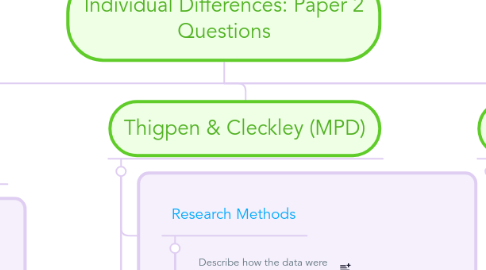
1. Individual Differences
1.1. Outline
1.1.1. Outline what is meant by the ‘individual differences approach’ in psychology. [2]
1.2. Evaluation
1.2.1. (What problems may psychologists have when they try to investigate individual differences? [9]
1.2.2. What are the advantages of investigating individual differences? [9]
2. Rosenhan (Sane in Insane Places)
2.1. Research Methods
2.1.1. Describe how the data were collected in this study. [3]
2.1.2. Describe how the longitudinal method is used in this study. [3]
2.1.3. Describe one piece of qualitative data from the Rosenhan study. [3]
2.2. Alternative Study
2.2.1. Design an alternative study using a self report and describe how it could be conducted. [10]
2.2.1.1. Evaluate this alternative way [self-report] of studying staff behaviour towards patients in psychiatric hospitals in practical and ethical terms. [10]
2.3. Issues & Debates
2.3.1. Describe how this study is useful [3]
2.3.2. Describe how this study supports the situational explanation of behaviour. [3]
2.3.3. Discuss the strengths and weaknesses of making generalisations from the study by Rosenhan. [10]
2.3.4. Compare and contrast the use of quantitative and qualitative data using Rosenhan’s study as an example. [10]
2.3.5. Describe a generalisation that can be made from this study [3]
3. Thigpen & Cleckley (MPD)
3.1. Research Methods
3.1.1. Describe how the data were collected in this study. [3]
3.1.2. Describe the use of a psychometric test in this study. [3]
3.1.3. Compare and contrast the psychometric testing approach as used by Thigpen and Cleckley with one other way of gathering data. [10]
3.1.4. Describe how the longitudinal method is used in this study. [3]
3.1.5. Describe the longitudinal method and outline how it was used in the Thigpen and Cleckley study. [5]
3.1.6. Describe the qualitative data in this study. [3]
3.2. Alternative Study
3.3. Issues & Debates
3.3.1. Discuss the extent to which individual and situational explanations of Eve’s behaviour are supported by Thigpen and Cleckley’s findings. [10]
3.3.2. Design an alternative study using the snapshot method and describe how it could be conducted. [10]
3.3.2.1. Evaluate this alternative way of studying multiple personality disorder in methodological and practical terms. [10]
4. Billington (Cognitive Styles)
4.1. Research Methods
4.1.1. Describe how the data were collected in this study. [3]
4.1.2. Describe the use of a psychometric test in this study. [3]
4.1.3. Outline the snapshot method and describe how it was used in Billington et al’s study. [5]
4.1.4. Describe how the snapshot method was used in this study. [3]
4.2. Alternative Studies
4.2.1. Design an alternative study to the Billington et al study using the longitudinal method and describe how it could be conducted. [10]
4.2.1.1. Evaluate this alternative way of studying empathising and systemising in practical and ethical terms. [10]
4.3. Issues & Debates
4.3.1. Describe how this study has been useful [3]
5. Veale & Riley (BDD)
5.1. Individual Differences Approach
5.1.1. Explain why Veale and Riley’s study is an example of the individual differences approach. [3]
5.1.2. Discuss the strengths and weaknesses of the individual differences approach as used in the study by Veale and Riley. [10]
5.2. Research Methods
5.2.1. Describe how the data were collected in this study. [3]
5.3. Alternative Studies
5.3.1. Describe how this alternative study could be conducted. [10]
5.3.1.1. Evaluate this alternative approach to studying this problem in psychology in practical and ethical terms. [10]
5.4. Issues & Debates
5.4.1. Describe an ethical guideline raised in this study. [3]
5.4.2. Discuss the extent to which the findings of Veale and Riley’s study can be applied to everyday life. [10]
